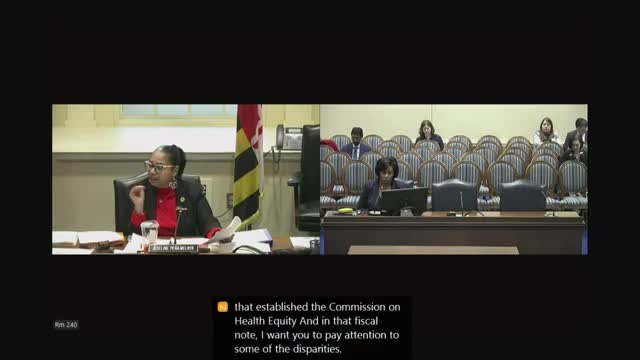Maryland leaders confront health disparities as COVID data reveals racial inequities
January 22, 2025 | Health and Government Operations Committee, HOUSE OF REPRESENTATIVES, Committees, Legislative, Maryland
This article was created by AI summarizing key points discussed. AI makes mistakes, so for full details and context, please refer to the video of the full meeting. Please report any errors so we can fix them. Report an error »

In a recent session of the HGO Committee held on January 22, 2025, the stark realities of health disparities in Maryland took center stage, as committee members delved into the troubling statistics that reveal a widening gap in health outcomes among different racial and ethnic groups. The meeting, marked by a sense of urgency, highlighted the ongoing challenges faced by communities of color, particularly in the wake of the COVID-19 pandemic.
The discussion began with a powerful acknowledgment of the data that underscores these disparities. Prince George's County, home to a significant population of people of color, reported the highest number of COVID-19 cases in the state, with the ZIP code 20783 emerging as the most affected area. This community, characterized by its diverse immigrant population, has been disproportionately impacted by health issues, including maternal and infant mortality rates, which are alarmingly higher for Black women compared to their white counterparts.
Committee members expressed deep concern over the implications of these statistics, noting that while Black individuals make up nearly 30% of Maryland's population, they accounted for 36% of COVID-19 deaths. The meeting also shed light on the persistent challenges of HIV incidence and emergency room visits for substance use and chronic conditions like diabetes and hypertension, which continue to plague these communities.
As discussions progressed, the committee emphasized the need for actionable solutions. Recommendations were made for the establishment of regular meetings with health equity centers at local universities and the Maryland health information exchange, CRISP, to leverage data for better health outcomes. The call for collaboration extended to historically Black colleges and universities, urging them to contribute to the fight against health disparities.
The committee's frustration was palpable as they called for a shift from mere analysis to concrete action. Members urged the office to explore legislative changes that reflect the current health landscape and to actively seek grants from both federal and private sources to fund programs aimed at addressing these disparities.
In conclusion, the session underscored a collective commitment to tackling health inequities in Maryland. As the committee looks ahead, the focus will remain on transforming data into meaningful action, ensuring that the voices of marginalized communities are heard and that their health needs are prioritized. The urgency of the situation calls for a collaborative effort, one that not only identifies problems but also implements effective solutions to foster a healthier future for all Marylanders.
The discussion began with a powerful acknowledgment of the data that underscores these disparities. Prince George's County, home to a significant population of people of color, reported the highest number of COVID-19 cases in the state, with the ZIP code 20783 emerging as the most affected area. This community, characterized by its diverse immigrant population, has been disproportionately impacted by health issues, including maternal and infant mortality rates, which are alarmingly higher for Black women compared to their white counterparts.
Committee members expressed deep concern over the implications of these statistics, noting that while Black individuals make up nearly 30% of Maryland's population, they accounted for 36% of COVID-19 deaths. The meeting also shed light on the persistent challenges of HIV incidence and emergency room visits for substance use and chronic conditions like diabetes and hypertension, which continue to plague these communities.
As discussions progressed, the committee emphasized the need for actionable solutions. Recommendations were made for the establishment of regular meetings with health equity centers at local universities and the Maryland health information exchange, CRISP, to leverage data for better health outcomes. The call for collaboration extended to historically Black colleges and universities, urging them to contribute to the fight against health disparities.
The committee's frustration was palpable as they called for a shift from mere analysis to concrete action. Members urged the office to explore legislative changes that reflect the current health landscape and to actively seek grants from both federal and private sources to fund programs aimed at addressing these disparities.
In conclusion, the session underscored a collective commitment to tackling health inequities in Maryland. As the committee looks ahead, the focus will remain on transforming data into meaningful action, ensuring that the voices of marginalized communities are heard and that their health needs are prioritized. The urgency of the situation calls for a collaborative effort, one that not only identifies problems but also implements effective solutions to foster a healthier future for all Marylanders.
View full meeting
This article is based on a recent meeting—watch the full video and explore the complete transcript for deeper insights into the discussion.
View full meeting
